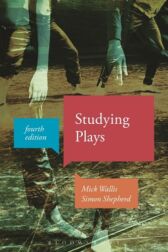Synopsis
Studying Plays
Published by Methuen
Using familiar examples of classic and contemporary works such as Shakespeare's King Lear, Ibsen's A Doll's House and Timberlake Wertenbaker's Our Country's Good, the book explores the essential elements of play texts, from character, dialogue and plot to theatrical space
With more in depth guidance on how to study plays in and as performance, both live and in recordings available online, Studying Plays now includes:
★ New examples throughout the book drawn from a range of 21st-century plays by established and emergent writers for diverse theatres and companies
★ New explorations of how plays structure and engage audience response
★ A complete new section on the analysis of Theatre of Witness and Testimony, Monodrama and Postdramatic texts
TABLE OF CONTENTS
Introduction
1. Getting Started
2. Characters and Persons
3. Dialogue
4. Plot and Action
5. The Actor's Body
6. Spaces
7. Dealing with Some New Kinds of Text
8. Culture and Interpretation
Glossary
Bibliography
Index
REVIEWS
"This newly revised classic, now with a much-needed section on the postdramatic, will grace the studio as much as the seminar room, empowering the next generation of students to talk about plays with genuine precision and insight" ~ Jonathan Pitches, Professor of Theatre and Performance, University of Leeds, UK
"Studying Plays attends to the diverse critical practices essential to the multidisciplinary study of drama. Ranging across formal elements of drama to bodies, space, and the cultures of performance, it suggestively engages undergraduates, instructors, and a wider audience" ~ W. B. Worthen, Alice Brady Pels Professor in the Arts, Barnard College, Columbia University, USA
"The durability of this excellent book confirms the importance of comprehensive and detailed methodical explanations of how drama works and becomes theatre. Essential reading for all young practitioners and students" ~ Peta Tait, Professor of Theatre and Drama, La Trobe University, Australia
"Studying Plays offers a model of diversity in terms of the examples it draws on from a range of periods and genres, but also in terms of the race, gender and sexuality of those who made the work discussed. That it does so without compromising the depth and rigour of the analysis is a testament to the skill and commitment of the authors. The combination of breadth, depth and rigour makes it a book that students and their tutors can return to again and again"~ Kate Dorney, Lecturer in Drama, University of Manchester, UK
 $25.99
$25.99